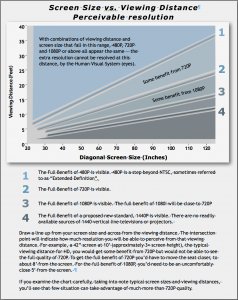Broadcasting & Cable (among others) are reporting a Neilsen report that:
New Nielsen data shows that more than three-quarters of all U.S. homes have HD TVs, up 14% from last year, and that nearly 40% of homes have multiple HD sets. Yet the same data shows that most viewing is still taking place in standard definition.
In May 2012, 61% of all primetime viewing was done on an HD set, but much of that viewing was of standard definition feeds, according to Nielsen. During that month about 29% of English-language broadcast primetime viewing and 25% of cable prime viewing was in “true HD,” the study found.
For “true HD” viewing to occur, the HD set must be connected to an HD signal and the set needs to be tuned to a HD channels.
So 75% of homes have HD sets but only 29% of viewing is done in HD. That parallels exactly my own observations about the use of HD on HD sets! I interpret that to mean that to mean 29/25% of the total audience, so about half those with HD sets do not watch HD on them. I’ll bet a lot of those folk don’t even realize they’re not watching HD, partly because the scalers in modern TVs and computers do an excellent job of faking the bigger image, and people sit back far enough that they don’t need the resolution HD provides.

3 replies on “Most people with HD TVs do not watch “true HD”.”
I would guess my own TV watching is somewhere around 50/50. Many of the shows I watch via Netflix or Hulu are in SD (480p). Most broadcast TV that I watch is broadcast at 720p or 1080i via OTA.
All this makes me wonder how readily adoptable the consumer market will be towards 4K. If the average user can’t even tell a difference between SD and HD—whether because they don’t know, or sit to far away, or the scalers are good enough to mask much of the differences—why would they want to upgrade to 4K. And if we, the content makers, still aren’t pushing out content in HD which has been readily doable for over a decade now, how much less likely are we to move to 4K cameras, bigger storage, proper monitors/screens, etc. That’s a tremendous cost on just the production and post-production end.
My higher-level takeaway from this is something that is very hard to state charitably, but since we’re all smart people here, hopefully none will take offense.
That is that once again it has affirmed for me that way too many people are simply bumbling idiots when it comes to even the most pedestrian technology. Sure, tech can, AND SHOULD be made easier to use, but there’s only so much you can do. Take a deeper look into this demographic and you’ll find that for a good portion of them this applies to at least one other non-tech area of their lives as well. It comes from a failure at the individual level to check facts and educate oneself. Maybe that’s due to laziness, distraction by other life events/activities, or actual inability to learn+understand, but the end result is the same. As someone who sometimes produces advertising, I can tell you that advertisers know this well. This especially factors in political advertising, as you can imagine I’m sure. I’ll say no more on that topic.
Anyway, all that to say, understanding demographics, and how long adoption curves are…is to understand the human race at some point. LOL. The only way you’ll get them to stop watching the SD over the HD is to remove the SD option.
Ryan,
I think many people that watch SD but think it’s HD will be some of the first to adapt 4K because they probably judge quality based on marketing and not what they see with their own eyes. “I have an HDTV therefore I must be watching HD and HD is better than SD so of course my HDTV looks better than my old SD TV”. Plus, TV makers need to push the ‘next big thing’ to market and it’s not 3D anymore. As manufacturing costs come down I think 4K sets will become more common, 1080p sets will become the new ‘lower end’ models and 720p sets will stop being made. Eventually 1080p sets will stop being made and the only option will be 4K sets.
As for the move on the post/production end it’s already happening. Sure it hurts now but I bet in 6 or 7 years editing in 4K will be no more of a chore than editing in HD is now. I mean, look at what it took to shoot and edit HD in 2005 vs today (where we expect our phones to shoot video in HD). I think broadcast will stay HD because the costs associated with moving broadcasting facilities and satellites to 4K will be massive and internet streaming/download will be even more in play than it is now.
Whether or not the change will happen is not dependent on end users being being able to see a difference, IMO. They just need to believe they can see a difference (and that their TV is better than their neighbors).